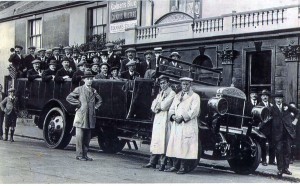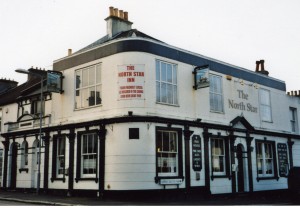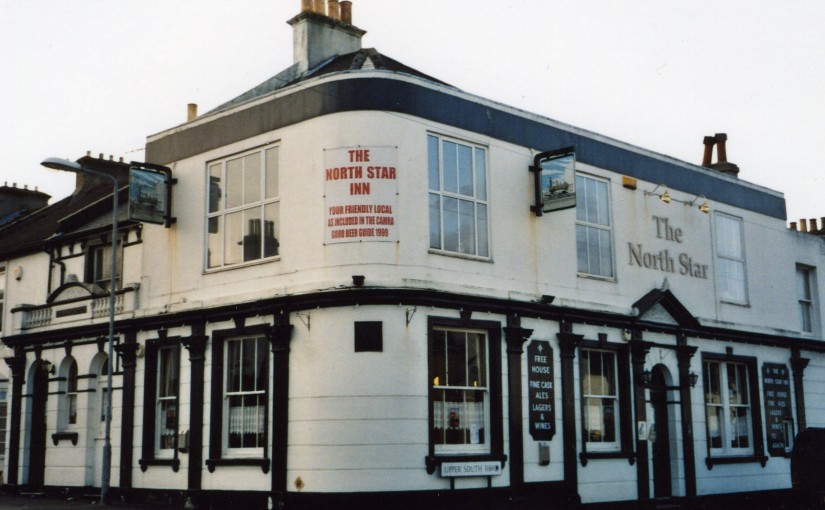By John Hodges
Within the last one hundred and fifty years, the area known as Bohemia could boast eight public houses, several off licenses, and a “pub” that didn’t sell beer at all. Seven of these pubs were west of Bohemia Road, while just one was east of this busy street. Today on the western side of Bohemia, there are just two of these public houses remaining , whilst to the east the one original pub still survives, this is the North star. But it was almost fifty years before the North Star opened that significant development commenced in the area. The most imposing building of this newly developing area was Bohemia House, which subsequently became Summerfields and was built in 1818 on the site of the old farmhouse. John “Yorky” Smith was one of the men engaged in the building of this mansion, his previous works included the Martello Towers between Eastbourne and Hastings and subsequently Pelham Crescent and St Mary in the Castle. Princess Sophia of Gloucester stayed there in 1830 an event causing much rejoicing in the town of Hastings as the presence of Royalty did much to promote the claims of a developing town.
However, there are mentions of this area in documented sources going back many hundreds of years, including the records of the Magdalen Charity a trust that still exists to this day. The existence of the former Central European state of Bohemia also did much in the past to promote speculation as to the origins of the local district of the same name. In fact in 1383 Princess Anne, daughter of King Charles IV of Bohemia, came across to England to marry King Richard II but unfortunately for the romantics neither of these facts establish a link with Hastings. The earliest factual mention of Bohemia occurs on Yeakell and Gardner’s County map of 1783 when a reference is made to a “Bohemy Farm”, this is followed in John Stell’s Hastings Guide of 1794 when the current spelling Bohemia is first used. This emergence of Bohemia at the beginning of the 19th Century coincides with Hastings own increasing prominence as a seaside resort and Bohemia Farm’ s position on one of the many popular inland walks. Indeed, it looks fairly certain that the name Bohemia came from the popular activity in the area of taking one’s tea “Bohemian or Gipsy” fashion, followed by helpings of Syllabub a dish similar to a cream trifle which had gained this lonely farmhouse a notable reputation.
By some considerable distance the oldest of the public houses and beer houses serving this expanding district was the Wheatsheaf opening its doors in 1835. This was followed in 1853 by a long defunct beer house The Bricklayers Arms, lasting less than twenty years, and was soon followed by the Hearts of Oak, which for a short period was known as The Barleycorn, opening in the 1860s. The Prince of Wales opened in 1866, quickly followed by The Bohemia Arms, The Dripping Spring, and The Tower, all around 1866/67. It is interesting to note how this progression of licensed premises were built in a South to North direction, no doubt following the direction of building development. The North Star was the last of the Bohemia public houses to arrive, built in the late 1860s it was granted its first licence in 1871 to Joseph Wisden, previously a guard on one of the several railway companies serving the south coast. In its earliest days The North Star attracted numbers of hawkers and other itinerants who gathered there in support of fairground activities that took place on the adjacent land that was subsequently developed into the pleasant residential streets that we know today. Another activity associated with the public house was an annual Guy Fawkes celebration. Commencing in the 1880s the Bohemia Bonfire Boys used the North Star as their headquarters, and from here the local procession set off around the adjoining streets, preceded by a brass band, as a precursor to joining the main parade in Hastings. For many years The North Star was an active member of the Watney’s games league, unfortunately on several occasions ending up with the wooden spoon. But whilst it may not have been their sporting prowess over the years that became their binding force, it was certainly their appreciation of all things sporting that remained strong, as the attached image of an outing to The Derby back in the 1920s bears witness.

Coach Outing from the North Star on Derby Day Coach Outing from the North Star on Derby Day The name “North Star” could have come from the world of astronomy as an alternative name for the Pole Star, but considering the previous occupation of the first landlord it is far more likely to have commemorated the famous broad gauge engine of that name. The Star class broad gauge engines were designed and built by Robert Stephenson , the North Star specifically was delivered to the GWR in November 1837. Although it was withdrawn from service in 1871, having been rebuilt in 1854 with new cylinders and wheelbase, it remained at Swindon until 1906 when it was broken up. But this was not the end of the story as by 1925 the North Star had been rebuilt using many of the original parts that had been secretly stashed away, and to this day remains on display in the Swindon Railway Museum.
As with many privately owned public houses, as indeed was the status of The North Star following a grant of a ninety nine year lease to the first landlord, it is unclear exactly from where the supply of beer would have originated. It is most unlikely that it was brewed on the premises, although the site is well provide with potential space for such a facility. With brewers such as Hewetts of St.Leonards and Breeds of Old Hastings being located locally, it is highly probable that either or both of these established businesses could have been one of the earliest suppliers. What we do know however is that either by a direct route, or via ownership by the Chandlers Wiltshire Brewery of Bethnal Green, the pub became part of the Watneys Group. It is well documented that Watney, Combe, Reid bought a large parcel of Hastings pubs around 1898, and acquired further additions when they bought fourteen houses from the Chandlers Wiltshire Brewery in 1910. And it would have been beers produced by Watneys that were enjoyed during the many years that The North Star traded under the sign of the red barrel. Hastings represented an important trading area for this company, and this statement can be verified by the fact that when the rationing of beer accompanied the start of the First World War, the Hastings depot was one of only four provincial establishments that were not sold off by Watneys in their bid to protect the supply of beer to their London houses.

The North Star Inn – Bohemia The North Star Inn – Bohemia Probably in anticipation of the impending break up of the large pub owning brewers, many Watneys pubs were disposed of, and this included The North Star. In 1996 this public house became part of a new empire of pub owning companies, free of tie to any brewer, but in their own right able to tie the leaseholder of their pubs to a prescribed, but excellent range of alcoholic products. As with many of these “free houses” they went through a series of landlords all looking for that magic formula, that makes for a successful pub. The current landlord of The North Star has very clearly found that collection of ingredients that produces success, one of those being hard work on a series of events, food nights, and high quality beers always presented in first class condition. It is interesting to note that the original application for a licence for The North Star contained the usual testimonial from the local worthies of the district including the name of the Rev S. Hadden Parkes. I am certain that this worthy gentleman would not be disappointed with what he would find in this excellent hostelry should he be able to visit it today.
“Hastings Town” April 2015
All articles, photographs and drawings on this web site are World Copyright Protected. No reproduction for publication without prior arrangement. © World Copyright 2015 Cinque Ports Magazines Rye Ltd., Guinea Hall Lodge Sellindge TN25 6EG
